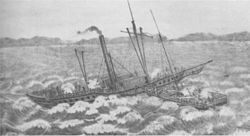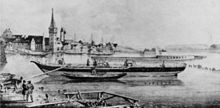Ludwig (ship, 1837)
|
Collision with the Mercury 1841
|
||||||||||||||
|
||||||||||||||
|
||||||||||||||
|
||||||||||||||
|
||||||||||||||
The Ludwig was the first steamer with an iron hull on Lake Constance .
history
Construction and launch
After the good experience on Lake Zurich with the steamer Minerva , the first iron paddle steamer on a Central European body of water, it was decided in the Kingdom of Bavaria to also use an iron ship in Lake Constance shipping. The Ludwig was built in the William Fairbairn machine factory in Millwall near Manchester and brought to Lake Constance in individual parts. The future steamer could be transported by water as far as Mannheim , the route through the Black Forest to Ludwigshafen was covered with horse and ox carts, and the not yet assembled Ludwig made the last section of the journey from Ludwigshafen to Lindau on sailing ships. The assembly in Lindau was led by the master mechanic Lämmlin from Rapperswil.
The ship received the name of the Bavarian king and was to be launched on September 6, 1837. However, the wooden stacking sledge collapsed before the ship could be lowered into the water. The stern got stuck on the mainland and had to be towed into the water by Helvetia . At this point in time the machine was not yet assembled. The fitters operated the paddle wheels by hand to bring the ship to the equipment quay.
At the beginning of 1838, the Ludwig began its course trips.
Accidents
On July 18, 1841, there was almost a disaster when members of several Lindau associations went on a "pleasure trip" to Constance. Since the group was too big, the Merkur barge with 70 passengers was attached to the 400-person Ludwig . On the way they got caught in a two-hour hurricane-like storm. The tow ripped and the boat was thrown by the waves with the bow on the right wheel arch of the Ludwig . Although both ships were damaged, the crew managed to tether the drifting boat again and continue the journey.
On March 11, 1861, the steamer city of Zurich collided with the Ludwig at what is now the old mouth of the Rhine . Almost exactly a year earlier, the city of Zurich had collided with the Queen of Württemberg ; Fortunately, there were no personal injuries back then. The Ludwig should cross traffic between Lindau and on the day of the accident Rorschach provided. Captain Gerber had postponed the departure until late afternoon due to a storm and had the ship cast off in Lindau at around 5 p.m. There were mainly cattle dealers on board heading for St. Gallen ; their animals were tied up on the foredeck. The crew was complete except for the baggage conductor Sebastian Hinterhuber, who had missed the steamer's departure due to a visit to a pub. After dark and the occurrence of a snow storm, it was only possible to drive according to the compass . When a white light came into view in a south-westerly direction at around 6.15 p.m., it was assumed that they were already in front of the Rorschach harbor, which the Ludwig was supposed to reach around 6.30 p.m. Immediately afterwards, however, the Ludwig was rammed by a steamer, which disappeared into the darkness as quickly as it had appeared. Captain Gerber stopped the engines and ordered the lifeboat to be lowered and the passengers to be rescued. However, since all the lamps on board had been destroyed by the collision and panic was triggered by the ingress of water, none of the passengers escaped into the boat. The crew of the steamer that had rammed the Ludwig had apparently not registered the collision and also did not hear the ringing of the ship's bell that was used to call for help on the Ludwig . However, she noticed the kinked bowsprit and found that water was entering the city of Zurich . The captain therefore had the ship turn around and return to Rorschach in a journey of ten minutes. Here, too, the drama on the Ludwig was not noticed. Within a few minutes it sank over the stern. Captain Gerber, helmsman Lanz and sailor Riesch boarded the lifeboat at the last moment and reached Altenrhein after a few hours . 13 people and eleven head of cattle perished when the Ludwig went down.
The three survivors were acquitted of all guilt, since in the chaotic situation they could not have done more to save the passengers. One consequence of the sinking of the Ludwig was an improvement in the international signal order; to the white bow light came the green starboard - and the red port light .
The Bavarian marine engineer Wilhelm Bauer was able to lift the Ludwig from a depth of eleven meters with the help of twelve balloons in 1863. The damage to the ship was repaired and it started up again as Rorschach . The cargo ship company Gebrüder Helfenberger, which was now using the ship, was unable to withstand the competition from the other steam shipping companies and soon had to give up its regular service. The machine and boiler were removed from the Rorschach ex Ludwig ; the hull was still used as a propulsionless cargo ship. Later he received sails. In the 1870s, the ship got caught in a heavy storm off Lochau and sank again, laden with building materials for the Bregenz- Lindau railway line . It was lifted a second time, but it turned out to be beyond repair and was therefore scrapped. The ship's bell of Ludwig was preserved and is located at the entrance of the town hall Stedi in Nonnenhorn .
The "devil's ship"
After the Ludwig was withdrawn from the regular service, the Jura was purchased as a replacement . This was rammed in 1864 - also by the city of Zurich - and sank within a few minutes. The city of Zurich has long had the reputation of a "devil's ship". During a maneuver in Lindau harbor, she slit open the wheel arch of the city of Lindau ; later it collided with the Buchhorn screw steamer . A Bavarian correspondent finally stated that the city of Zurich should be sold to the Danes because it sank more German ships than the Danish navy.
literature
- Karl F. Fritz: Adventure steamship on Lake Constance , 2nd edition, Hinze, Meersburg 1990, ISBN 3-927484-00-8 , p. 20 ff.
- Werner Deppert: With a steam engine and a paddle wheel . The steamship on Lake Constance 1817-1967, Stadler, Konstanz 1975, ISBN 3-7977-0015-6 .
Web links
Footnotes
- ↑ "The most violent foehn storm of modern times prevailed on July 18, 1841. It drove devastatingly over all of Europe and part of Asia ..." Friedrich Pernwerth von Bärnstein: The steamship on Lake Constance and its historical development during its first main period (1824 -1847) . Deichert, Leipzig 1905, page 7, footnote 2 ( digitized version )
- ↑ Karl F. Fritz 1990, p. 34


